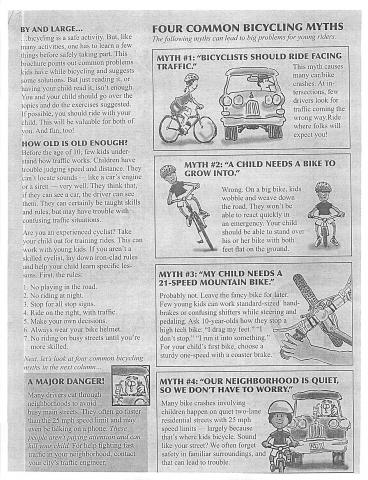Milwaukee230 West Wells Street - Suite 706 Tel - 414.207.4426 |
Madison403 Venture Court - Suite 2 Tel - 608.320.6710 |
Bike Safety for Children
Children have limited attention spans, are impulsive and engage in risky and dangerous behaviors. They lack the life skills and experience that most adults have when it comes to things like crossing the street in traffic, and scanning behind before pulling left on a bicycle. Children are children not young adults. It is important to understand children's limitations in understanding traffic. Specifically, children ■ Have a narrower field of vision than adults, 1/3 less. ■ Cannot easily judge a car's speed and distance ■ Assume that if they can see a car, its driver must be able to see them. However, children are easily hidden from view by parked cars and other objects ■ Cannot readily tell the direction a sound is coming from ■ May be impatient and impulsive ■ Concentrate on only one thing at a time, this is unlikely to be traffic ■ Have a limited sense of danger ■ Often mix fantasy and reality ■ Imitate the often bad behavor of others, espeically older children and adults. Below are 10 ways to help your children when they are out riding and acting as pedestrians. Keep in mind that while most crashes in Wisconsin invovling adult bicyclists are due to motor vehicles, most of crashes involving children are the child's fault. Thanks to City of Madison, DOT, and Traffic Engineering for the tips. 10 ways to help your children: 1. Always model appropriate traffic safety practices youself, whether you are walking, bicycling or driving. Children learn from important people around them. 2. Give your child only as much independence and responsibility as he or she can handle safely. Throughout childhood, children slowly develop the cognitive, perceptual and sensory skills necessary to be safe in traffic. 3. Remember that each child is unique. Do not base rules for one child on those for siblings, cousins, or neighbors. Children of the same age may require different levels of supervision in traffic. 4. Evaluate your child's behavior out of traffic. Is he or she impulsive. Does he or she stop to think before acting? Distractable? Can he or she sustain attention on something important? Is he or she a risk taker? It is likely that your child's behavior in trafic will resemble behavior out of traffic. 5. Consider any limitations your child has and how these might includence his or her behavior in traffic. For example, does your child have visioni problems? Hearing impairment? Cognitive or judgment limitations? Physical handicaps? 6. Give your child practice in traffic. Frequent supervised experiences can help children develop good traffic safety habits. 7. Teach your child the rules of walking and bicycling safety as you encouter traffic situations. Ask your children to repeat rules back to you. 8. Do not assume your child will follow the rules just because he or she can verbalize them. Let your child lead you in traffic to help you assess how well he or she follows the rules. Set up situations with your child in which you shadow him or her. Walk 10-15 feet behind to allow semi independence. 9. Grant independence in small steps to see how your child handles it. For exmaple, let your child progress from playing in front of the house to playing on the block, to walking around the block, to crossing one street etc. 10. Be a careful driver, watch for children who may not yet have developed good traffic saety habits. Their safety is in your hands. 



